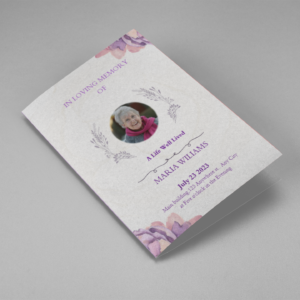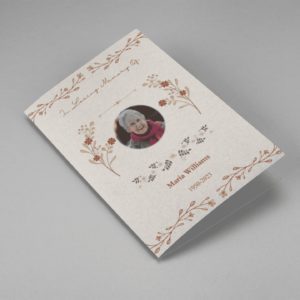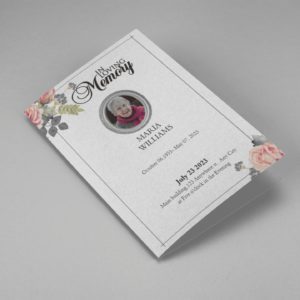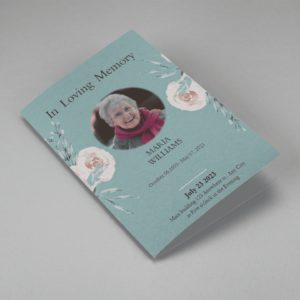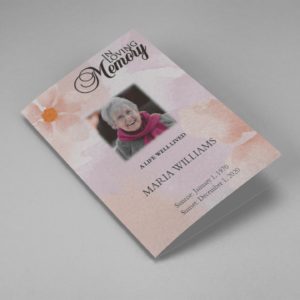Memorial cards are a timeless way to honor and remember a loved one who has passed. They serve as lasting keepsakes, providing family and friends with a tangible memory to hold onto and cherish. Creating beautiful funeral memorial cards can be a meaningful part of the memorial process, allowing you to express sentiments, celebrate life, and provide a source of comfort to those who attend the service.
Why Create Funeral Memorial Cards?
Funeral memorial cards, also known as remembrance cards, are a small but meaningful gesture that can make a significant impact. These cards typically include a photo of the deceased, a short obituary, favorite verses or quotes, and sometimes a prayer. They can be handed out during the funeral service or mailed afterward as a keepsake for family and friends. Here are some reasons why these cards are so valued:
- Tangible Keepsake: They provide loved ones with a physical reminder that they can hold onto, look at, and reflect upon.
- Celebration of Life: Memorial cards are an opportunity to capture the essence of the deceased, celebrating their life, character, and values.
- Comfort and Support: For those grieving, holding a memorial card can be a comforting way to feel connected to the loved one who has passed.
- Tradition and Respect: Many families find comfort in following customs that include distributing memorial cards as a sign of respect and remembrance.
Key Elements of a Beautiful Memorial Card
Creating a meaningful funeral memorial card involves combining thoughtful words with visual elements that reflect the individual’s personality and legacy. Here are the main elements to consider:
1. The Photo
Including a clear, warm photo of the deceased is one of the most impactful elements of a memorial card. This photo is often chosen to reflect the individual in their prime or during a happy moment in life. Some tips for selecting the photo include:
- Clarity: Choose a high-resolution image that prints well.
- Expressiveness: Select a photo that captures the spirit or character of the person, such as one where they are smiling or engaged in an activity they loved.
- Context: Consider whether the person is alone in the photo or with loved ones, as either option can be meaningful.
2. Meaningful Text
Text on a memorial card generally includes the person’s name, birth and death dates, and a personal message. Additional elements might include:
- Quotes or Verses: Select words that reflect the person’s beliefs, values, or life outlook. Bible verses, poetry lines, or inspirational quotes are common choices.
- Personal Message: This could be something written by the family or a short note expressing gratitude for those who are there to remember the individual.
- Obituary or Short Biography: A few lines summarizing the individual’s life achievements, family, and character traits.
3. Design and Style
The card design can enhance the sentiment you wish to express. This might include:
- Color Scheme: Use colors that resonate with the individual’s personality or ones that evoke peace, such as soft blues, greens, or earthy tones.
- Backgrounds and Borders: Subtle patterns, floral accents, or frames can add an elegant touch.
- Typography: Opt for fonts that are easy to read and appropriate for the tone of the card. Simple, classic fonts often work best for memorial cards.
4. Verses and Prayers
Many families choose to include a prayer or verse on their memorial cards. This could be something from scripture, a favorite poem, or an inspirational saying. Here are some examples:
- Religious Verses: “The Lord is my shepherd; I shall not want.” – Psalm 23:1
- Inspiring Quotes: “Those we love don’t go away; they walk beside us every day.”
- Personalized Messages: Lines that reflect the person’s life or your family’s shared sentiments can add an intimate touch.
5. Customization Options
Modern printing and design tools allow for a high degree of personalization. You can customize the layout, colors, fonts, and images on the card, ensuring each element reflects the person’s spirit. For instance:
- Add Personal Touches: Customize with the deceased’s favorite colors or a pattern that represents their hobbies or passions.
- Use Unique Shapes: Instead of a standard rectangular card, try oval or heart-shaped options if that feels fitting.
- Incorporate a Collage: Some families choose to include multiple photos to show the person at different life stages.
Step-by-Step Guide to Creating a Memorial Card
Here’s how you can design and print a beautiful, memorable funeral card:
Step 1: Select a Template
Using a template can make the design process easier, especially if you’re not familiar with design software. Many websites offer customizable templates where you can upload photos, edit text, and change colors.
Step 2: Add Personal Information
Fill in the details, such as the deceased’s full name, birth and death dates, and any other relevant information. You may also include the funeral or memorial service location and time if you’re distributing the cards before the service.
Step 3: Insert Photos and Text
Upload a chosen photo and place it in a prominent spot on the card. Add any quotes, verses, or messages that reflect your loved one’s character or faith. Be mindful of spacing to ensure everything is readable and well-balanced.
Step 4: Customize Design Elements
Adjust colors, fonts, and backgrounds to align with the tone you wish to convey. Try to keep the design simple and elegant, allowing the photo and text to be the main focus.
Step 5: Review and Proofread
Take a moment to review the design carefully. Check for any spelling errors or typos, as well as alignment issues. You may want to ask another family member to look over the card as well.
Step 6: Print the Cards
Select a high-quality printing option, preferably with thicker, glossy paper that will give the card a polished look. You can either print the cards at home or use a professional printing service.
Tips for Creating a Lasting Memorial Card
To make sure your card is a cherished keepsake, consider the following tips:
- Keep It Simple: A simple, elegant design often has the greatest impact.
- Reflect the Person’s Life: Incorporate elements that speak to the unique qualities of your loved one.
- Choose Quality Materials: Using high-quality paper and printing can make a big difference in the look and feel of the card.
- Proofread Carefully: Ensure the card has no typos or inaccuracies, as this will reflect the care you put into the tribute.
Funeral Memorial Card Template
-
Searching for a Oak Leaf With Gold Oval Frame Half Page Funeral Program that is easy to print and amass and has a cutting-edge look? The Oak Leaf With Gold Oval Frame Half Page Funeral Program is the Perfect decision because it measures 8.5”x 5.5”.
- No Limitation on Content, Edit anything
- Edit anytime – unlimited revisions even after purchased
- Get a printable PDF downloaded to get it printed on your own.
-
Searching for a Brown and White Classic Funeral Program Half Page Program that is easy to print and amass and has a cutting-edge look? The Brown and White Classic Funeral Program Half Page Program is the Perfect decision because it measures 8.5”x 5.5”.
- No Limitation on Content, Edit anything
- Edit anytime – unlimited revisions even after purchased
- Get a printable PDF downloaded to get it printed on your own.
-
Searching for a Purple Elegant Watercolor Half Page Funeral Program Template that is easy to print and amass and has a cutting-edge look? The Purple Elegant Watercolor Half Page Funeral Program Template is the Perfect decision because it measures 8.5”x 5.5”.
- No Limitation on Content, Edit anything
- Edit anytime – unlimited revisions even after purchased
- Get a printable PDF downloaded to get it printed on your own.
-
Searching for a Cream and Green Photo Obituary Half Page Program that is easy to print and amass and has a cutting-edge look? The Cream and Green Photo Obituary Half Page Program is the Perfect decision because it measures 8.5”x 5.5”.
- No Limitation on Content, Edit anything
- Edit anytime – unlimited revisions even after purchased
- Get a printable PDF downloaded to get it printed on your own.
-
Searching for a Cream Simple Elegant Photo Church Half Page Program that is easy to print and amass and has a cutting-edge look? The Cream Simple Elegant Photo Church Half Page Program is the Perfect decision because it measures 8.5”x 5.5”.
- No Limitation on Content, Edit anything
- Edit anytime – unlimited revisions even after purchased
- Get a printable PDF downloaded to get it printed on your own.
-
Searching for a Samovar Silver Half Page Funeral Program Template that is easy to print and amass and has a cutting-edge look? The Samovar Silver Half Page Funeral Program Template is the Perfect decision because it measures 8.5”x 5.5”.
- No Limitation on Content, Edit anything
- Edit anytime – unlimited revisions even after purchased
- Get a printable PDF downloaded to get it printed on your own.
-
Searching for an Elegant Beige Half Page Funeral Program Template that is easy to print and amass and has a cutting-edge look? The Elegant Beige Half-Page Funeral Program Template is the Perfect decision because it measures 8.5”x 5.5”.
- No Limitation on Content, Edit anything
- Edit anytime – unlimited revisions even after purchased
- Get a printable PDF downloaded to get it printed on your own.
-
Searching for a White Floral Pro Half Page Funeral Program Template that is easy to print and amass and has a cutting-edge look? White Floral Pro Half Page Funeral Program Template is the Perfect decision because it measures 8.5”x 5.5”.
- No Limitation on Content, Edit anything
- Edit anytime – unlimited revisions even after purchased
- Get a printable PDF downloaded to get it printed on your own.
-
Searching for a Grey and Burgundy Elegant Half Page Funeral Program Template that is easy to print and amass and has a cutting-edge look? Grey and Burgundy Elegant Half Page Funeral Program Template is the Perfect decision because it measures 8.5”x 5.5”.
- No Limitation on Content, Edit anything
- Edit anytime – unlimited revisions even after purchased
- Get a printable PDF downloaded to get it printed on your own.
-
Searching for a Soft Green and Grey Minimalist Floral Half Page Funeral Program Template that is easy to print and amass and has a cutting-edge look? Soft Green and Grey Minimalist Floral Half Page Funeral Program Template is the Perfect decision because it measures 8.5”x 5.5”.
- No Limitation on Content, Edit anything
- Edit anytime – unlimited revisions even after purchased
- Get a printable PDF downloaded to get it printed on your own.
-
Searching for a Gray Elegant Oval Frame Half Page Funeral Program Template that is easy to print and amass and has a cutting-edge look? Gray Elegant Oval Frame Half Page Funeral Program Template is the Perfect decision because it measures 8.5”x 5.5”.
- No Limitation on Content, Edit anything
- Edit anytime – unlimited revisions even after purchased
- Get a printable PDF downloaded to get it printed on your own.
-
Searching for a Blue Organic Minimal Half Page Funeral Program Template that is easy to print and amass and has a cutting-edge look? Blue Organic Minimal Half Page Funeral Program Template is the Perfect decision because it measures 8.5”x 5.5”.
- No Limitation on Content, Edit anything
- Edit anytime – unlimited revisions even after purchased
- Get a printable PDF downloaded to get it printed on your own.
-
Searching for a Pink and Orange Watercolour Half Page Funeral Program Template that is easy to print and amass and has a cutting-edge look? Pink and Orange Watercolour Half Page Funeral Program Template is the Perfect decision because it measures 8.5”x 5.5”.
- No Limitation on Content, Edit anything
- Edit anytime – unlimited revisions even after purchased
- Get a printable PDF downloaded to get it printed on your own.
-
Searching for a Pink Floral Paper Half Page Funeral Program Template that is easy to print and amass and has a cutting-edge look? Pink Floral Paper Half Page Funeral Program Template is the Perfect decision because it measures 8.5”x 5.5”.
- No Limitation on Content, Edit anything
- Edit anytime – unlimited revisions even after purchased
- Get a printable PDF downloaded to get it printed on your own.
Funeral Programs : Helping Videos
Frequently Asked Question On Create Beautiful Funeral Memorial Cards
What size are typical funeral memorial cards?
Most funeral memorial cards are wallet-sized, about 2.5 x 4 inches, making them easy to carry or place in a photo album. However, you can customize the size based on personal preference.
Can I create memorial cards myself?
Yes, many people create memorial cards at home using templates from websites or design software. It’s also common to use a professional printing service for high-quality results.
What should I include on a funeral memorial card?
Include the name of the deceased, birth and death dates, a photo, and a short message, prayer, or quote. Some families also add a brief obituary or list of survivorrs.
Are there any specific colors used in funeral memorial cards?
While there are no strict rules, many choose muted or soft colors like white, cream, blue, and green. Some families prefer colors that held significance to the deceased.




